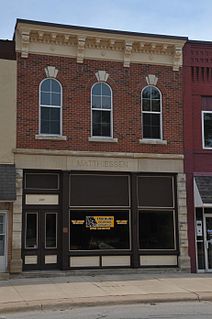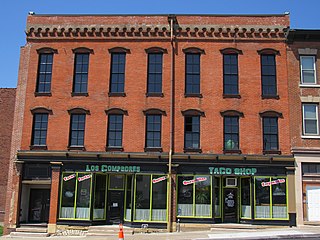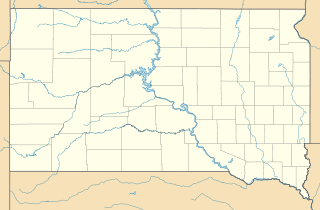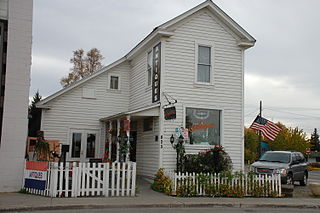
The Odd Fellows Hall in Covington, Kentucky is located at the northeast corner of Fifth Street and Madison Avenue. It was constructed in 1856 by the Independent Order of Odd Fellows Lodge, and was the center of Covington's civic and political life for most of the Victorian era. When the American Civil War ended, victorious Union Gen. Ulysses S. Grant was honored with a reception there.

The Wales and Hamblen Building is a historic commercial building at 260 Main Street in Bridgton, Maine. Built in 1882, it is a fine example of late Italianate architecture, and one of the town's most architecturally sophisticated commercial buildings. It was listed on the National Register of Historic Places.

The Ancient Free and Accepted Masons Lodge 687, also known as the Independent Order of Odd Fellows J.R. Scruggs Lodge 372, is a building constructed in 1876 as a Masonic Hall. It is located in downtown Orangeville, Illinois, a small village in Stephenson County. The building, originally built by the local Masonic Lodge, was bought by the locally more numerous Independent Order of Oddfellows fraternal organization in 1893. The building has served all of Orangeville's fraternal organizations for more than 125 years, from the time it was built. The two-story, front gabled building has Italianate architecture elements. It had a rear wing added to it in 1903. By 2003, the first floor has been returned to use as a community center, holding dinner theatre and other community functions, much as the building had originally served the community until first floor space was rented out for commercial use in the late 19th century. The building was listed on the U.S. National Register of Historic Places in 2003. The building is the home of the Mighty Richmond Players Dinner Theatre (MRPDT) dinner theatre which seats 54 persons and has scheduled four different productions for the 2010 season. A $150,000 renovation of the building was recently completed. The building was listed on the National Register of Historic Places as AF and AM Lodge 687, Orangeville in 2003.

The Odd Fellows' Hall is a historic Odd Fellows' hall at 1-5 State Street on the Buckland side of Shelburne Falls, Massachusetts. Built in 1877, and rebuilt after a damaging fire in 1895, it has been a focal point of the business district on the Buckland side of the village since its construction, serving an active Odd Fellows chapter until 1963. The building was listed on the National Register of Historic Places in 1979. In 1988 it was included in the Shelburne Falls Historic District.

Union Hall is a historic meeting hall near the junction of Depot and Central Streets in Danforth, Maine. Built in 1890, the hall has served since then as a venue for private and public events, including town meetings and other municipal functions, and as a meeting point for fraternal organizations including the Masons and the Odd Fellows. It is a prominent landmark in the village center. The building was listed on the National Register of Historic Places in 1987.

The Lakeside Grange No. 63 is a historic Grange hall on Main Street in Harrison, Maine. Built in 1905, it has served as a major community meeting space since then, notably surviving a 1907 fire that destroyed part of the town's center. It was listed on the National Register of Historic Places in 2005.

The I.O.O.F. Building is an Independent Order of Odd Fellows building located in Woodland, Yolo County, Northern California.

The Odd Fellows-Rebekah Hall is a historic form fraternal society hall on High Street in Cornish, Maine. Built in 1902 for the local chapter of the International Order of Odd Fellows and their associated Rebekah women's chapter, it is an architecturally eclectic mix of vernacular and high-style elements. It was listed on the National Register of Historic Places in 1983, and now functions as a community meeting space.

The I.O.O.F. Hall is an Independent Order of Odd Fellows building located on Main Avenue in Challis, Idaho. The building was constructed in two sections; the first was built prior to 1894, while the second was added in 1896. The front facade features two raised gables with decorative Queen Anne woodwork; both gables were connected by a larger gable in 1930. The Odd Fellows were a significant social group in Challis' early history, as almost all of the town's founders were members of the organization. The hall was used for nearly every large community event in Challis during the early 1900s, including dances, public exhibitions, and even the meetings of other fraternal organizations.

The Odd Fellows Hall is a historic building located at 516 Main St. in Salmon, Idaho. The building was constructed in 1874 as a meeting place for Salmon's chapter of the International Order of Odd Fellows. The wood frame building was designed in the Greek Revival style and features Ionic pilasters on its front face. A wooden front designed to resemble cast iron was added to the building in 1888. The Odd Fellows built a new meeting hall, the Salmon Odd Fellows Hall, in 1907. The original building is one of the few remaining fraternal halls from the 1800s in Idaho.

The Odd Fellows Hall in Monticello, Iowa was built in 1871. It is a narrow, 20 feet (6.1 m) by 65 feet (20 m) Italianate commercial building.

The Wupperman Block/I.O.O.F. Hall is a historic building located just north of downtown Davenport, Iowa, United States. It was individually listed on the National Register of Historic Places in 1983. In 2020 it was included as a contributing property in the Davenport Downtown Commercial Historic District.

The Lake Oswego Odd Fellows Hall, in Lake Oswego, Oregon, was built in 1890. It was listed on the National Register of Historic Places in 1979. It served historically as a meeting hall of the local Independent Order of Odd Fellows chapter, which formed in 1888. It also has served as a specialty store and in other uses.

The Odd Fellows Building is a historic commercial building on Main Street in Gary, South Dakota. It is a two-story brick building, with a decorative corbeled cornice. It has a typical retail plate-glass front on the first floor, and sash windows with stone lintels on the second floor. It was built in 1889 by the local chapter of the International Order of Odd Fellows, and was used both by that fraternal organization for its meetings and events, but also for local town meetings. The ground floor has housed a variety of commercial enterprises over the years, as well as a museum.

The New Glarus Town Hall in New Glarus, Wisconsin, was built in 1886 to house both the town hall and a meeting place for the Ancient Order of United Workmen. It was added to the National Register of Historic Places in 2008.

The Hardman IOOF Lodge Hall is a meeting hall in the ghost town of Hardman in the U.S. state of Oregon. Completed in 1900, it was added to the National Register of Historic Places in 2012.

The former Bridgewater Town Hall and Jail are a pair of civic buildings on United States Route 1 in the center of Bridgewater, Maine. Built in 1894 and c. 1910 respectively, the buildings are the best-preserved and most architecturally distinguished of the community's surviving early civic structures. The town hall, in addition to its government functions, also hosted fraternal and social organizations, as well as community events. The buildings were listed on the National Register of Historic Places in 1990.

The Oddfellows House, also known as Oddfellows Hall, is a former fraternal clubhouse of Oddfellows at 825 1st Avenue in Fairbanks, Alaska. It is a wood-frame building with two sections, the front one a narrow two-story structure, the rear one a wider single-story structure. Each section has its own gable roof, although they do briefly align. The building was built in 1907 by Madame Renio, a fortune teller, and initially housed a clinic and residential space in the front and a bathhouse in the rear. The bathhouse business failed after its pipes froze in the winter of 1909–10, and the building was purchased by the local chapter of the International Order of Odd Fellows (IOOF). This fraternal organization converted the front space into a kitchen and bathroom, and the rear was converted into a large meeting hall. Under the IOOF's ownership the hall was used by a wide variety of civic and religious organizations, including its sister organization, the Golden North Rebekahs. The IOOF chapter was inactive between the late 1930s and 1945, but the Rebekahs continued to maintain the building, eventually taking ownership in 1967. The Rebekahs disbanded in 2007, and the space was briefly used as a museum; it now houses a retail establishment.

The Murray General Merchandise Store, also known as Murray Hall, is a historic building located in Little Sioux, Iowa, United States. A native Scot, Michael Murray operated a general store from this location from 1877, when it was built, to 1916 when he died. The second floor housed the local chapters of the Masons, Independent Order of Odd Fellows, Order of the Eastern Star, Grand Army of the Republic, and the Woodmen. By the 1970s the Masons and the Eastern Star were the only two remaining, but they folded in the 1980s. The Harrison County Historic Preservation Commission took possession of the building in the 1990s to preserve it. Since then it has served a community social hall, and served as city hall briefly in 1996 when the old city hall was destroyed in a fire.

The Saratoga Masonic Hall is a two-story brick building in downtown Saratoga, Wyoming that houses Saratoga's Masonic lodge. Established in 1892, the lodge was the fourteenth to be established in Wyoming. After a time in rented space, the lodge bought the Couzens and Company Block in 1893, using the second floor for meetings and leasing the ground floor to storekeeper A. Johnson Dogget. From 1895 the ground floor was used as a school. The Masons allowed a variety of other organizations to use the building, including the Odd Fellows, Knights of Pythias, Pythian Sisters, Union Fraternal League, Modern Woodmen, Women of Woodcraft, Job's Daughters, the Republican Party and the Ku Klux Klan.






















